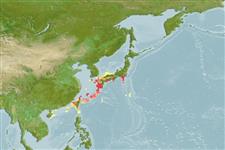>
Mulliformes (Goatfishes) >
Mullidae (Goatfishes)
Etymology: Upeneus: Greek, ypene, -es = upper lip (Ref. 45335); itoui: Named for Mr. Masahide Itou who collected almost all Kagoshima specimens of the new species and kindly made them available to the authors. Sakuya-himeji and Oriental Goatfish are herein proposed as the standard Japanese and English names, respectively, for the species (Ref. 88711).
Environment: milieu / climate zone / depth range / distribution range
Ecologie
marien demersaal; diepte 23 - 27 m (Ref. 88711). Tropical
Northwest Pacific: southern Japan.
Grootte / Gewicht / Leeftijd
Maturity: Lm ? range ? - ? cm
Max length : 12.3 cm SL mannelijk / geslacht onbekend; (Ref. 88711)
Korte beschrijving
Determinatiesleutels | Morfologie | Morfometrie
Dorsale stekels (totaal) : 7; Dorsale zachte stralen (totaal) : 9. A species of Upeneus with the following combination of characters: dorsal-fin rays VII + 9, first dorsal-fin spine longest; pectoral-fin rays 13–15 (usually 14); gill rakers 6 or 7 (mode 6) + 16–18 (17) = 22–25 (23); pored lateral-line scales 28–30 (29); no teeth on ectopterygoids; maximum body depth 20.9–24.7% SL (mean 22.7%); maximum head depth 18.0–20.6% SL (19.2%); barbel width 6.0–7.8% HL (7.0%); barbels white; a distinct reddish brown stripe from tip of snout to caudal-fin base through eye in life and fresh specimens; first dorsal fin with 4 irregular white bands in life, 4–6 irregular reddish brown bands (retained as dark bands in preserved specimens) and 4–6 white bands in fresh specimens; upper caudal-fin lobe pale white with 5–7 reddish brown bands (retained as dark bands in preserved specimens) and 5–9 irregular pure white bands in life and fresh specimens; lower caudal-fin lobe reddish with 5–9 short red bands (retained as dark bands in preserved specimens) and 5–9 short white bands or spots along ventral margin in life and fresh specimens (Ref. 88711).
Levenscyclus en paargedrag
Maturities | Voortplanting | Spawnings | Egg(s) | Fecundities | Larven
Yamashita, M., D. Golani and H. Motomura, 2011. A new species of Upeneus (Perciformes: Mullidae) from southern Japan. Zootaxa 3107:47-58. (Ref. 88711)
Status op de Rode Lijst van het IUCN (Ref. 130435)
Gevaar voor de mens
Harmless
Gebruik door de mens
Tools
Speciale rapporten
Download XML
Internetbronnen
Estimates based on models
Fylogenetische diversiteitsindex (Ref.
82804): PD
50 = 0.5000 [Uniqueness, from 0.5 = low to 2.0 = high].
Bayesian length-weight: a=0.00955 (0.00454 - 0.02011), b=3.10 (2.93 - 3.27), in cm total length, based on LWR estimates for this Genus-body shape (Ref.
93245).
Trofisch niveau (Ref.
69278): 3.4 ±0.4 se; based on size and trophs of closest relatives
Weerstandsvermogen (Ref.
120179): Hoog, minimale populatieverdubbelingstijd minder dan 15 maanden (Preliminary K or Fecundity.).
Fishing Vulnerability (Ref.
59153): Low vulnerability (10 of 100).
